Injury Prevention Exercises: 9 Easy Movements
How to Exercise to Prevent Injury
Finding a workout routine that you enjoy and can stick to is something to be celebrated. Moving consistently brings a sense of empowerment and accomplishment. And the more you move, the better you will feel. Still, it’s important to take into account any old injuries or discomfort in your body you may experience. At one point or another, many of us have felt nervous about injuring ourselves while exercising. Sometimes that fear of injury will cause enough worry to prevent you from increasing your challenge or trying something new that you might enjoy. Therefore, it’s essential to support your body’s unique needs throughout your routine to stay pain and injury free. Doing some little things on a regular basis can make a big difference. As we age, these little things become critical for maintaining our mobility and continuing to do what we love.
What are ways to prevent injury?
No one can wave a magic wand and prevent injury. But, we can make it far less likely by integrating these simple practices and injury prevention exercises into your daily routine.
#1: Practice noticing
First and foremost, practice noticing how your body feels. When you do Pilates, or any movement routine that connects breath to movement, you will begin to notice how your body feels when you move. Don’t ignore this. This mental “muscle”—the practice of noticing your body as you move—is your barometer, both while you are exercising and throughout all aspects of your day. When you pay attention to how you feel, if something doesn’t seem quite right you can make the decision to get curious and pay attention to the sensation or stop moving.
#2: Ask for help
Don’t work through pain and please seek support from a medical professional if you feel pain. The process of getting stronger will occasionally bring about some soreness. Increasing your routine and trying more challenging workouts may lead to those sensations. That’s a very normal part of training our body. Noticing the difference and knowing when to stop and seek help from a physician or physical therapist is key. Having a Pilates trainer help set up your workout or routine provides “eyes on your body”. That will help you create a program suited to your unique needs and prevent injury right from the start.
#3: Pace yourself
This is truly an instance of slow and steady winning the race. Make sure that you are trying more challenging routines or adding minutes to your workout a little at a time. Large jumps in intensity can lead to injury. Give your body time to adapt at its own pace.
#4: Build a foundation
Be sure to do some whole body movement like Pilates that will move your spine, shoulders and hips. These foundational movements will engage the core muscles to help keep the forces of whatever you do moving through your body in a balanced way. A key benefit of Pilates is that it focuses on individual postural issues and helps each person unravel their own unique muscular imbalances to create healthy movement patterns. Improved overall fitness levels may help prevent injury plus offer greater strength and ease of movement.
What exercise causes the most injury?
The simple answer: too much, too soon. Of any type of exercise. It often feels like we live in a culture of extreme fitness trends with the mantra go big or go home. Any workout your body is not prepared for is the one that brings the most risk. If you do something high impact or extremely cardiovascular without easing yourself into that activity, your body is going to be caught off guard. Anyone who has ever decided to take up running and thought they’d just head out and try to run a mile will know what I mean. By starting slowly, first walking, then jogging to start building endurance you’ll safely be able to progress to a running routine. Even in Pilates, if you once attended advanced classes but then took some time off, you’ll need to revisit the basics.
Jumping right back into complex movements without taking time to reinforce the foundational movements can leave you vulnerable to injury. Taking inspiration from a favorite silly board book about a bear hunt that I used to read to my kids, I like to say we have to go through the forest, not around, over or under it. The goal is to have you safely engage in movement in whatever range your body will allow, and then progress from there in ways that allow you to own that movement and experience joy and confidence in doing so.
How can I exercise without damaging my joints?
Exercises that move your spine in all of its planes of motion are important. Then, keeping hip joints mobile and having your legs and hips moving freely is important. This helps to keep the hips, core and back working together. It’s also important to make sure your abdominal and back muscles are engaging when they are needed. This will keep you from any strain in your trunk and support each movement. The nice thing about Pilates is that it’s easy on the joints. The mat exercises are low impact bodyweight training, so the forces on your bones will help you maintain bone density safely. There is so much you can do with just a mat and you.
Injury prevention exercises
In general, there are three characteristics of a successful home routine that I like to emphasize: consistency, progression, and balance. Moving your body every day in all planes of motion and through all the joints of the body will keep you strong and prepared for the type of unexpected movements that can cause injury. These exercises will mobilize the whole body, connect breath to movement, and are safe to do every day. You know what they say… an ounce of prevention is worth a pound of cure.
Arm Circles
Begin lying on your back with your knees bent and feet hip distance apart. Place your arms by your sides with your palms facing in towards the body. Take a nice inhale to lift your arms up toward the ceiling and then reach them overhead only as far as ribcage and shoulder stabilization can be maintained. Exhale to circle your arms wide out to sides and return down to your starting position. Repeat 4 times and switch directions for four circles.
Half Roll Back
Start seated on a mat with your feet flat on the floor, knees bent in front of you. Start upright in a neutral position with arms reaching in front of you parallel to the floor. While exhaling, start to roll your pelvis away from your femurs (legs) so that you feel your low abdominal muscles hugging into your spine. You are creating a “C” shape with your low back while keeping your shoulders wide and relaxed. Keep the “C” shape and inhale. Then, exhale to fold forward at the hips over your legs. Stack up your spine from tail to head and float your arms back to the starting position.
Hip Rolls
Start lying on your back with your knees bent and feet hip distance apart. Your arms are by your sides. Take a deep breath into the sides of your rib cage and feel yourself grow long through your spine. As you exhale, recruit your abdominals into an imprinted position by feeling your hip bones and ribs pull closer together until there is little or no gap between your spine and the floor. Once imprinted, articulate your spine starting from the tail to roll up into a bridge position where wide shoulders support your weight. Your hip joints are extended, and your knees should feel they are energetically reaching long over your toes. Take an inhale to stay here at the top, then roll down as you exhale to return to your starting position. Imagine your sit bones reaching toward your heels as you articulate down through your spine. Repeat eight times.
Mid-Back Spinal Rotation
Begin kneeling with elbows bent under shoulders and knees under hips. Your spine should be in a neutral position and feel as though it’s reaching long from tail to head. Your shoulder blades are stable against your rib cage. As you exhale, reach your elbow to the ceiling lead as you open your chest and allow your spine to rotate. Inhale to return to your starting position and repeat with your other arm. Repeat four times on each side.
Hip Circles
Begin kneeling on all fours with arms underneath shoulders, and knees directly underneath hips, slightly apart. Your spine should be reaching long from tail to head. Shift your weight to your right hand and knee and then circle your hips back to your heels on the right side then continue to shift your hips to the left side. Pull your pelvis underneath you as you continue the circle towards the starting position while arching your back like a cat. Feel that great cat stretch. You are making a circle with your spine first in extension and then flexion as you continue the movement. Do four to the right and then four to the left.
Bird-Dog Variation
Begin kneeling on all fours with arms underneath shoulders, and knees directly underneath hips, slightly apart. Your spine should be reaching long from tail to head. Inhale and find extra length through the spine. Exhale to recruit your abdominals and simultaneously lift your right arm and left leg, reaching towards opposite ends of the mat. Hold this balanced position as you inhale and reach fingertips and toes even longer. As you exhale, simultaneously lower your arm and leg to the starting position. Repeat on the other side. Be sure to keep your head level with your spine and keep length through the back of your neck.
Cat Stretch
Begin kneeling on all fours. Your arms should be underneath your shoulders and knees directly underneath the hips, slightly apart. Feel your spine reaching long from tail to head. Inhale to grow longer and find length through the spine. As you exhale, use your abdominals to round your spine like a Halloween cat. Start from your tailbone and leave the head for last. Hold this c-curve position while you inhale to breathe into the sides of your ribcage, rounding further. Finish with an exhale and beginning with the tail end of the spine, extend one vertebra at a time until you return to your starting position. Repeat six to eight times.
Squats
Stand tall with your feet wider than your hips. Propping your heels on a blanket or rolled up mat can be a helpful modification when you are just starting out with these deep squats (see video). Be sure your toes are pointed forward or slightly turned out and that your knees track over your feet. Your hands can hang by your sides. Bend at the knees and hips as though you are going to sit in a chair and go as far down as you can. Your weight will be in your heels. Keep your back straight and your gaze directed low in front of you. Pause at your lowest point for a moment then return to your starting position. Repeat four times.
Standing Side Arch
Stand with feet hip distance apart. Your weight should stay evenly distributed on both feet and your spine long and neutral. On an inhale, lift your arms over head while keeping your shoulders lengthened down. Grab your left wrist with your right hand overhead. As you exhale, lengthen your waist and spine and reach the heel of your hand away from the heel of your foot. Keep both sides of your body long and hips level. Be sure to stay square to the front and avoid rotating. Return to standing tall, switch the grip of your hands and repeat on the other side.
Move More, Feel Better
The price of a healthy body and personal wellness is hard to pinpoint because, in a way, health is defined by the absence of illness or injury. Sometimes we need a little guidance getting started in a safe way for our body. That’s why Elaine Economou created Movement Essentials: Getting Started with Pilates, a 28-day program at MOVE On Demand designed to get you moving safely and keep you on track. Each week Elaine introduces you to the basic principles of Pilates with a consistent warm up, weekly classes, and a variety of special topics to enhance your journey. And, it comes with an easy-to-follow calendar that will guide you through a clear progression and provide a foundation for healthy movement. Watch the trailer to learn more. Support the activities you love to do in life by starting today!

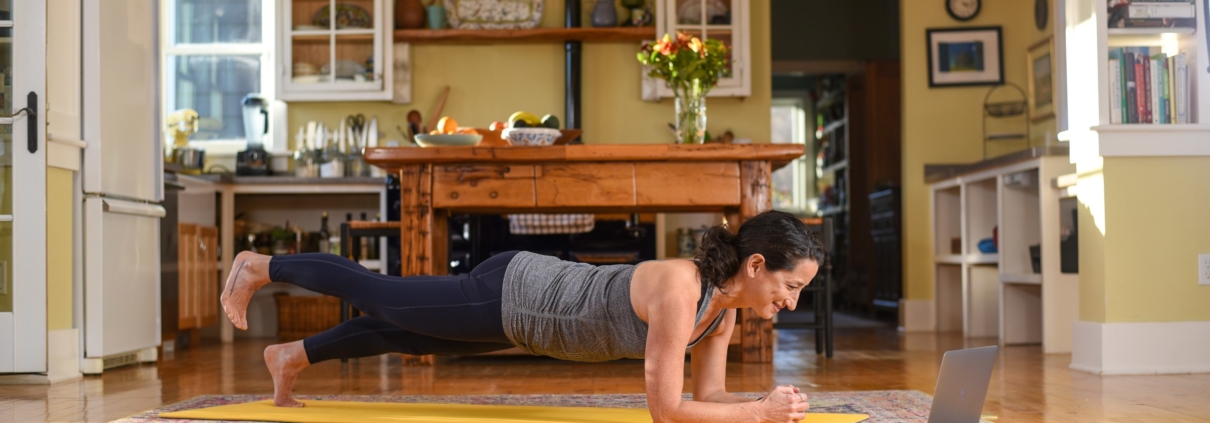
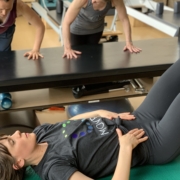
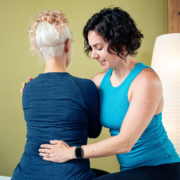
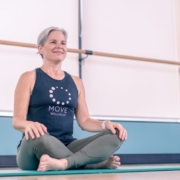
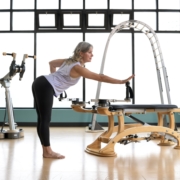
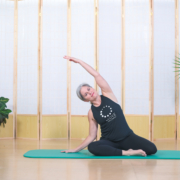
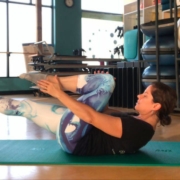


Leave a Reply
Want to join the discussion?Feel free to contribute!